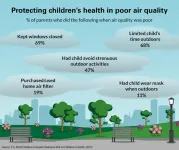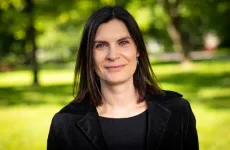(Press-News.org) A new study published in a Nature Partner Journal, npj Microgravity, finds an engineered compound given to mice aboard the International Space Station (ISS) largely prevented the bone loss associated with time spent in space. The study, led by a transdisciplinary team of professors at the University of California at Los Angeles (UCLA) and the Forsyth Institute in Cambridge, Massachusetts, highlight a promising therapy to mitigate extreme bone loss from long-duration space travel as well as musculoskeletal degeneration on Earth.
Microgravity-induced bone loss has long been a critical concern for long-term space missions. Decreased mechanical loading due to microgravity induces bone loss at a rate 12-times greater than on Earth. Astronauts in low Earth orbit may experience bone loss up to 1% per month, endangering astronaut skeletal health and increasing risk for fractures during long-duration spaceflight and later in life.
The current mitigation strategy for bone loss relies on exercise-induced mechanical loading to promote bone formation but is far from perfect for crewmembers spending up to six months in microgravity. Exercise does not always prevent bone loss, takes up valuable crew time, and may be contraindicated for certain types of injuries. The new study led by Chia Soo, MD, vice chair for research in the Division of Plastic and Reconstructive Surgery, professor in Departments of Surgery and Orthopaedic Surgery at UCLA David Geffen School of Medicine, investigated whether systemic delivery of NELL-like molecule-1 (NELL-1) can reduce microgravity induced bone loss. Discovered by Kang Ting, DMD, DMSc at the Forsyth Institute, NELL-1 is crucial for bone development and bone density maintenance. Professor Ting also led numerous studies to show that local delivery of NELL-1 can regenerate musculoskeletal tissues such as bone and cartilage.
Systemic delivery of NELL-1 aboard the ISS requires the team to minimize the number of injections. Ben Wu, DDS, PhD and Yulong Zhang, PhD at the Forsyth Institute enhanced NELL-1's therapeutic potential by extending the molecule’s half-life from 5.5 hours to 15.5 hours without losing bioactivity, and bioconjugated an inert bisphosphonate (BP) to create a “smart” BP-NELL-PEG molecule that more specifically targets bone tissues without the common deleterious effects of BP.
The modified molecule was then extensively assessed by the Soo and Ting teams to determine the efficacy and safety of BP-NELL-PEG on earth. They found that BP-NELL-PEG displayed superior specificity for bone tissue without causing observable adverse effects.
To ascertain the practical applicability of BP-NELL-PEG in real space conditions, the researchers worked with Center for the Advancement of Science in Space (CASIS) and National Aeronautics and Space Administration (NASA) Ames to prepare extensively for the SpaceX CRS-11 mission to the ISS, where astronauts Peggy Whitson, PhD and Jack D. Fisher, MS carried out the studies. Half of the ISS mice were exposed to microgravity (“TERM Flight”) for a lengthy 9-week period to simulate the challenges of long-duration space travel, while the remaining mice were flown back to Earth at 4.5 weeks post-launch, for the first ever live animal return (“LAR Flight”) of mice in US history. Both TERM and LAR Flight groups were treated with either BP-NELL-PEG or phosphate buffered saline (PBS) control. An equivalent cohort of mice remained at the Kennedy Space Center and were treated similarly with BP-NELL-PEG or PBS to serve as normal Earth gravity (“Ground”) controls.
Both Flight and Ground mice treated with BP-NELL-PEG exhibited a significant increase in bone formation. The treated mice in space and on Earth displayed no apparent adverse health effects.
“Our findings hold tremendous promise for the future of space exploration, particularly for missions involving extended stays in microgravity,” said lead corresponding author Chia Soo. “If human studies bear this out, BP-NELL-PEG could be a promising tool to combat bone loss and musculoskeletal deterioration, especially when conventional resistance training is not feasible due to injuries or other incapacitating factors,” said co-co-principal investigator, Kang Ting.
“This bioengineering strategy can also have important benefits on Earth, offering a potential therapy for patients suffering from extreme osteoporosis and other bone-related conditions,” said co-co-principal investigator, Ben Wu.
“As the next step, UCLA project scientist, Pin Ha, MD, DDS, MS, is overseeing analysis of the live animal return data. We hope this will provide some insight on how to help future astronauts recover from longer duration space missions,” said Chia Soo.
The research is supported by grants from CASIS and National Institutes of Health. Additional funding and support are provided by UCLA Division of Plastic and Reconstructive surgery, UCLA Department of Surgery, UCLA Department of Orthopaedic Surgery and the UCLA Orthopaedic Hospital Research Center, the American Association of Orthodontists Foundation, and the International Orthodontics Foundation. Pin Ha and Yulong Zhang, and associate professor Jin Hee Kwak, DDS, are co-first authors and contributed equally to this project.
UCLA Media Contact:
Kelsie Sandoval
Senior Media Relations Officer
UCLA Health | https://www.uclahealth.org/
424-832-6570 | KNSandoval@mednet.ucla.edu
Forsyth Media Contact:
Jill Sirko, PhD
Manager of Communications
The Forsyth Institute | https://www.forsyth.org/
617-892-8320 | jsirko@forsyth.org
Article: Bisphosphonate conjugation enhances the bone-specificity of NELL-1-based systemic therapy for spaceflight-induced bone loss in mice, https://www.nature.com/articles/s41526-023-00319-7. DOI: 10.1038/s41526-023-00319-7.
END
Engineered compound shows promise in preventing bone loss in space
2023-09-18
ELSE PRESS RELEASES FROM THIS DATE:
European funding for the treatment of Type 1 diabetes using 3D bioprinting
2023-09-18
Javier Ramón Azcón, an ICREA research professor and the leader of the Biosensors for Bioengineering group at the Institute for Bioengineering of Catalonia (IBEC), has been granted an "ERC Proof of Concept Grant." This prestigious grant is awarded by the European Research Council (ERC) and aims to explore the commercial and societal potential of research projects that have been previously funded by the ERC. Recipients use this type of funding to verify the practical viability of scientific concepts, explore business opportunities or prepare patent applications.
Ramón's project has been named "Uniink" and centers ...
National Poll: 2 in 3 parents say their kids have experienced poor air quality
2023-09-18
ANN ARBOR, Mich. – As smoke from Canada's historic wildfires triggers poor air quality alerts across the country, many parents worry about the impact on their child’s health, a new national poll suggests.
Two-thirds of parents say over the past two years they have experienced at least one day with poor or unhealthy air quality in their area, according to the University of Michigan Health C.S. Mott Children’s Hospital National Poll on Children’s Health.
In response to poor air quality alerts, most parents kept their windows closed and limited ...
Why do some environmental shocks lead to disaster while others don't?
2023-09-18
It's no longer just about stopping, but how we can live with climate change. To figure this out, we must delve into our cultures, as highlighted in a special issue of The Royal Society. A study by the Complexity Science Hub points out how our history could help guide the way.
Currently, we are grappling with a global crisis convergence. Various types of threats intersect, intertwine, and test our collective resilience, from climate change and economic inequality to political polarization. Although the scale and global reach of these challenges present new hurdles, these threats have been faced and, sometimes, overcome in the past. Societies today ...
Captive pandas could be ‘jet lagged’ if their body clocks don’t match their environment
2023-09-18
All animals have an internal clock called a circadian clock, which is regulated by cues from their environment — but animals in zoos can be exposed to very different cues from animals in the wild. Since all animals’ circadian clocks are linked to their behavior and physiology, this could be significant to their welfare, which is crucial to maintaining captive populations of animals at high risk of extinction in the wild, like giant pandas. Scientists set out to understand how the ‘jet lag’ of living ...
MXene, a dream new material, paves the way for mass production
2023-09-18
Developed in 2011, MXene is a two-dimensional nanomaterial with alternating metal and carbon layers, which has high electrical conductivity and can be combined with various metal compounds, making it a material that can be utilized in various industries such as semiconductors, electronic devices, and sensors. To properly utilize MXene, it is important to know the type and amount of molecules covered on the surface, and if the molecules covered on the surface are fluorine, the electrical conductivity of decreases and the efficiency of electromagnetic wave shielding decreases. However, since it is only 1 nm (nanometer - billionth of a meter) thick, ...
What is the carbon footprint of a hospital bed?
2023-09-18
Researchers from the University of Waterloo completed the first-ever assessment of a Canadian hospital to reveal its total environmental footprint and specific carbon emission hotspots.
Studying a hospital in British Columbia during its 2019 fiscal year, the researchers identified energy and water use and purchasing of medical products as the hospital’s primary hotspots, accounting for over half of the yearly footprint, totalling 3500-5000 tons of CO2 equivalent. One hospital bed is roughly equivalent to the carbon footprint of five Canadian households.
The new method brings an unprecedented level of comprehensiveness and detail to hospital ...
Early treatment of child obesity is effective
2023-09-18
The early treatment of obesity in children is effective in both the short and long term, researchers from Karolinska Institutet report in a study published in The International Journal of Obesity.
The researchers followed over 170 young children in Sweden who had received treatment for diagnosed obesity. The children were recruited to the randomised controlled study when they were between four and six years old via children’s clinics in Region Stockholm.
The children and their parents were randomly assigned to one of three treatment conditions: standard treatment, parental support group, or parental support group with follow-up telephone ...
Study finds significant chemical exposures in women with cancer
2023-09-18
In a sign that exposure to certain endocrine-disrupting chemicals may be playing a role in cancers of the breast, ovary, skin and uterus, researchers have found that people who developed those cancers have significantly higher levels of these chemicals in their bodies.
While it does not prove that exposure to chemicals like PFAS (per- and poly-fluoroalkyl substances) and phenols (including BPA) led to these cancer diagnoses, it is a strong signal that they may be playing a role and should be studied further.
The study showed that particularly for women, higher ...
Societal collapse is underway and museums can be unlikely heroes, suggests expert
2023-09-18
Museums and Societal Collapse: The Museum as Lifeboat presents evidence and theories around collapse and extinction, while locating the responsibility of museums in our changing world
Stressors like climate trauma, corporate deceit and political incompetence signal the threat of societal collapse, a new book asserts.
This claim lays the foundation for exploring arguments of ‘collapsology’ in new work by Robert R. Janes Ph.D., Museums and Societal Collapse: The Museum as Lifeboat. The book also contends with the unique role that can be played by museums during a mounting climate crisis.
“Social ...
Transfer of ageing: New drug class prevents key ageing mechanism in organ transplants
2023-09-18
(18 September 2023, Athens, Greece) A novel study has shown that Senolytics, a new class of drugs, have the potential to prevent the transfer of senescence*, a key mechanism of ageing, and the associated physical and cognitive impairments in recipients of older donor organs. 1
The pioneering research, presented today at the European Society for Organ Transplantation (ESOT) Congress 2023, opens promising avenues for expanding the organ donor pool and enhancing patient outcomes.
By transplanting older donor organs into younger ...




